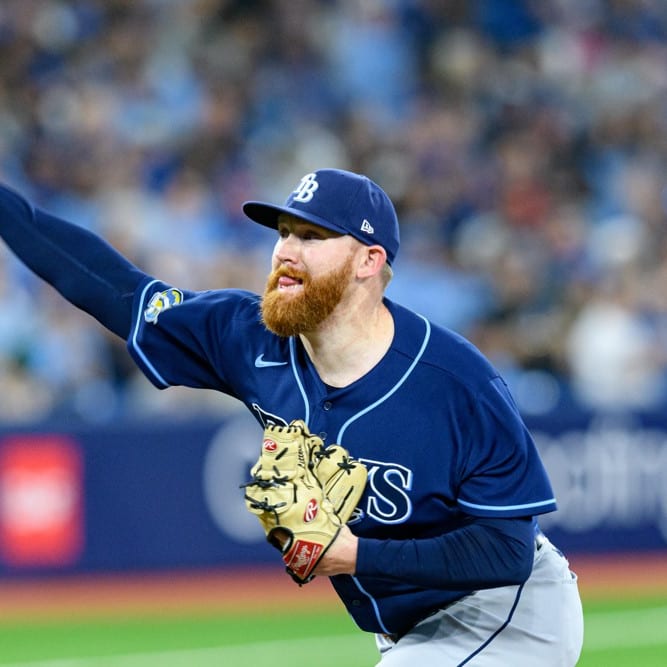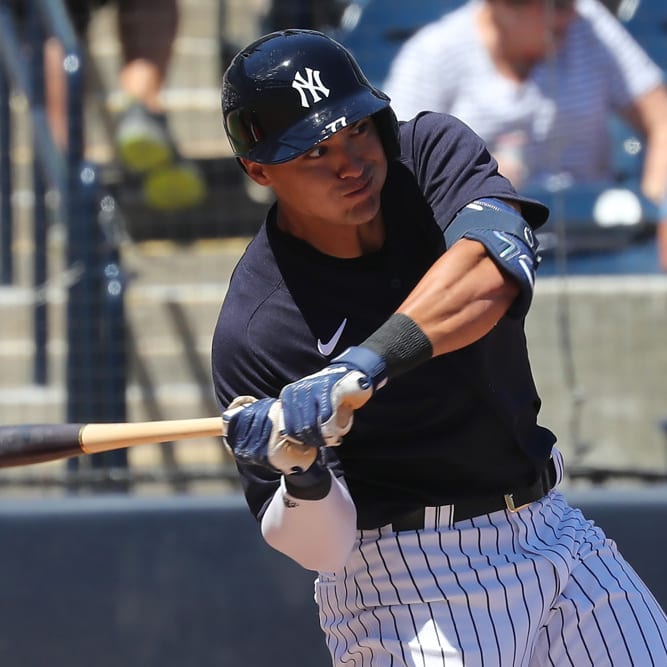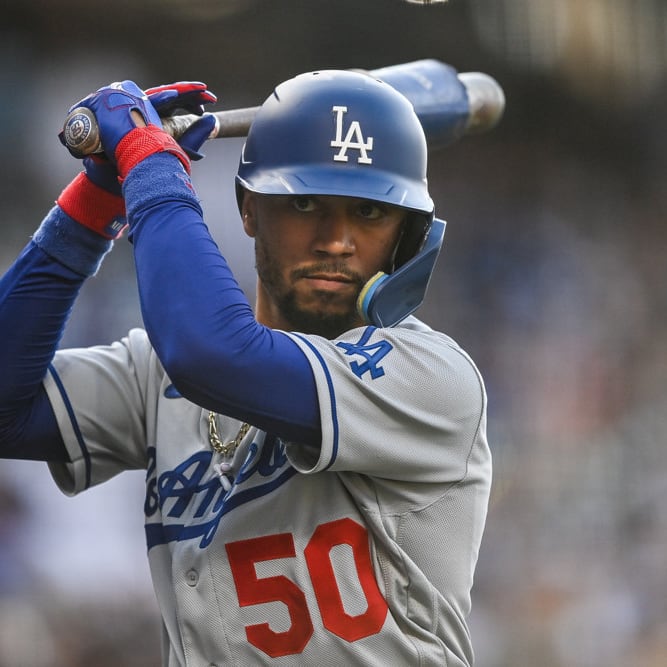This article is part of our Mound Musings series.
It's always a highlight of my baseball season. Draft day brings an infusion of new, and hopefully exciting, arms into professional baseball and into the spotlight for fantasy baseball junkies like us. I settled in Monday night with iced tea and snacks, notebook in hand, and a list of pitchers I wanted to check in on. Where would they go? What would the film clips show? What would other analysts have to say? What a night! Obviously, this is focused on keeper and dynasty formats, but the top guys will be on redraft fantasy draft boards sooner than you might think.
Some general observations from Draft Day
Most analyst saw this year's draft as pitching thin. In general, I would agree to a point, but I think it's more a lack of preparation than a lack of talent, especially among college prospects. High school arms, even the really good ones, have always been considered risky. There are injury risks, and the challenge of accurately predicting the ultimate ceiling of a younger pitcher, so many teams focus on the top college prospects. Besides, with an increasingly shallow pool of quality pitchers at the MLB level, teams desperately seeking help on the mound want that help as soon as possible.
I think, and it's just my opinion, that the current trend in the approach to pitching is now becoming more evident in both the high school and college pitchers arriving on draft days. I could be wrong, this year may have been an aberration, but there were a few things I saw as prevailing characteristics in the top pitching prospects in the 2019 draft. And, I find it a bit alarming.
Fair warning, I'm about to get on my old-fashioned soapbox.
In the high school arms I see many kids already approaching, and in some cases, hitting triple digits with jaw-dropping fastballs. Okay, I can understand that, at least in some respects. It's trendy (I hate that word as a traditionalist) to flash a huge arm at a very young age. After all, that 100 mph reading on a radar gun at age 16 might very well net your son a full-ride scholarship to a major college, or a single paycheck bigger than your aggregate earnings over the first 20 years of your career. I get it, I do. However, I'm afraid there is a potentially high price tag for that velocity.
If college is the next step, at least there is time to hone the other necessary skills. Of course that assumes a large part of the college experience won't be spent rehabbing from surgery to glue that big arm back onto the body. But, I am going to dismiss the possible injury concerns. That's a whole different rant. Instead, I will focus on what I saw in many of the college prospects. I'm pretty sure the MLB front offices feel they can develop those big high school arms once they are receiving professional coaching.
Here is the 600-pound gorilla in the room. The college pitchers fell into two categories. Group one was generally huge arms that seriously lacked quality secondary pitches and/or couldn't consistently command the pitches in their arsenals. Group two, and a smaller group, comprised pitchers with a three- or four-pitch repertoire, but who lacked that electric, high velocity fastball. In many cases, pitchers in this second group were marked down. The consensus seemed to be they had a mid-rotation ceiling, not what most teams are shopping for in the first round of a draft.
So, recognizing that pitching is a dire need, what is the answer? A one- or two-pitch pitcher is not going to make it as a starter at the MLB level, even if that one pitch looks like a spacecraft reentering the atmosphere. That is a ticket to the bullpen. Maybe that's the future? Several teams already deploy perhaps three traditional starting pitchers, while a collection of underdeveloped pitchers comprise a committee of relievers designated "openers" or "primary" pitchers to pitch the fourth or fifth days. Is that by choice or out of necessity? I hope it's the former, but I fear the preprofessional system is breeding a generation of bullpen arms.
We need a return to balance. Sure, I want to see the big arms, but can we again see college pitchers who can consistently hit their spots with a wide variety of pitches? Let's see a mix of breaking pitches and even a change-up capable of fooling a hitter looking for that big fastball. I want to be dazzled by the prospect who already displays the feel for changing eye levels and taking something off when it's evident the opponent is getting the timing down. I want to see pitchers.
Okay, off the soapbox. Let's take a look at the 2019 draft class.
Here are a few higher ceiling arms I think you should add to your watch list:
- Daniel Espino (Cleveland Indians – 24th overall) – I normally lean to college kids in the draft because they are more advanced and have more refined stuff making them a bit less risky when projecting their eventual ceiling, but this year this high school kid stood out to me. A native of Panama, he came to the States a couple years ago, and he is progressing in leaps and bounds. Espino already has an upper 90s fastball that runs, plus he cuts it too, and he possesses two different electric breaking pitches. Raw stuff, right now, in my opinion, his is the best of this year's crop, college or high school, which creates a significant gap between him and the other arms in this class. He's not the preferred size (he's just 6'0") so it's more of a challenge for him to get an ideal downward plane on his pitches, but I don't get too concerned with that. If he can garner more consistency with all of his pitches, his stuff is that of a legitimate ace. Only his age and experience level create any doubts at all. I'm high on him.
- Nick Lodolo (Cincinnati Reds – 7th overall) – He was the first pitcher taken in the draft, albeit with the latest pick for the first pitcher to go in the history of the draft. He probably deserved to be at the top of most pitching draft boards, but there are even some question marks with him. He was a three-year starter at TCU (a solid major college program). The tall (6'6") southpaw has pretty well developed mechanics, so there is a chance he won't take as long to lock in his release point like so many young lefties. He's not overpowering – at least not yet – but his fastball is comfortably in the low 90s and he has a crisp power slider. Those are his featured pitches, which is little bit of a concern. In pro ball, he is going to need better off-speed stuff (or more velocity on his fastball) to create more differential in the speed of his pitches. I like Lodolo, and I think he can eventually be a fantasy asset as a traditional starting pitcher if he adapts to the pro game, but I agree with most analysts who project him to be a No. 3 rather than a potential ace, which is what you normally expect from the top college pitcher in the draft. He's probably a couple years away.
- Alek Manoah (Toronto Blue Jays – 11th overall) – Manoah has a very big arm attached to a very big dude (6'6" and 260 lbs.). At West Virginia he basically stuck to two pitches – a fastball in the upper 90s that can tease triple digits, and a very nasty slider – but that's about it. I like how he uses his size to his advantage. He pitches downhill and he seems to almost be on top of the hitter. He's intimidating for sure, but the question is whether he can bring along a third pitch. If he can, he could be a top-of-the-rotation starter, but it's often a challenge for someone his size to keep everything in sync with a full repertoire. If that doesn't happen (I'm sure Toronto will give him a chance make it as a starter) he profiles as a late-inning reliever right now, and quality relievers are becoming a more integral part of the game all the time. He'll need to continue refining his secondary stuff and command, but there is definitely promise here.
- Zack Thompson (St. Louis Cardinals 19th overall) – I think he might have gone higher, but he had some elbow issues two seasons ago. The good news is he had a big year last season at Kentucky without any further problems. A big southpaw, he is perhaps the closest to the major leagues, which gets him a little more attention. He does have a four-pitch arsenal with relatively good command most of the time, which equals potential to make it as a starting pitcher. Some think he can eventually be top-of-the-rotation, but I'm not quite there. His stuff will need to improve for me to push him that far.
- George Kirby (Seattle Mariners – 20th overall) – A righty with a full four-pitch repertoire, he makes the list because he can throw all those pitches for strikes (107 strikeouts with just six walks last year). He has the type of motion that is pretty repeatable so the command should stick with him, but his stuff is currently fairly pedestrian, and coming out of Elon University, I question the quality of opposition he has faced. I like what I have seen of his mound presence, and it's not unusual to see a pitcher add a couple of ticks to the fastball, something I think could bump up his ceiling, but he needs to be monitored to see how he fares against more advanced hitters.
- Brennan Malone (Arizona Diamondbacks – 33rd overall) – Another big high school arm who needs to develop, but I think it's coming. He can get into the mid to upper 90s with movement, but the positives to me are the improvements to his breaking pitches. He'll add some spin, and presumably he'll add a change-up to fill out his repertoire. I list him as raw talent, which is not unexpected with high school kids, but I really like this one. He's probably similar in skill level with most of the high schoolers today, but I feel like he may have a bit more room to grow, increasing his ultimate ceiling. The Diamondbacks took three pitchers in the first 40 picks, and I like all of them, so Arizona fans have a lot to look forward to.
There were a lot of other pitchers worth monitoring – guys like Quinn Priester (18th overall to the Pirates) an athletic high school right-hander, Blake Walston (26th overall to the Diamondbacks) and Ball State's Drey Jameson (34th overall to the Diamondbacks) who will both join Malone in the Arizona organization, which gives them a pretty big edge in the overall pitching draft picture for this season. I was already watching JJ Goss (36th overall to the Rays) and Seth Johnson (40th overall to the Rays) who are two more big arms going to an excellent developmental organization, which makes them even more interesting to me. Jackson Rutledge (17th overall to the Nationals) who has a bit of a short arm delivery but is very imposing on the mound. Finally, one pitcher I thought might be on the top tier of draftees, right-hander Carter Stewart, is reportedly signing with the Fukuoka SoftBank Hawks in Japan. My guess is his contract could have some type of opt-out clause allowing him to return to the United States in a couple of years so he is another to track.
Some Notable Rotation Ramblings:
- Earlier this week, the Astros sent Corbin Martin back to Triple-A Round Rock after a disappointing audition in their rotation. I like his stuff, but he couldn't throw strikes (12 walks in 19 innings) and he seemed to struggle more with each outing. I think he'll be back, but he needs to regroup and get focused.
- I watched Nick Pivetta in his recent start against a Dodgers team that is very volatile if you aren't on your game, and I felt a lot better about my preseason expectations for him. He can't backslide now, but I'm optimistic that his time at Triple-A gave him the chance to find himself. If available, he's worth a shot.
- The Blue Jays are watching his pitch counts, and Clayton Richard isn't helping his own cause with nine walks in 12 innings, but as he shakes off the rust after missing the first couple months of the season recovering from a knee injury, he should hopefully improve enough to perhaps help a bit in very deep leagues.
- It's been three years, a Tommy John surgery, a major lat injury and a broken finger since the Cardinals' Alex Reyes has been a significant contributor, but he may be close to making an impact again. The team will no doubt closely monitor his workload, but he's too talented to pass on if your fantasy rotation is in need.
- Perhaps it's worth watching, Seattle's Yusei Kikuchi will rejoin the rotation this weekend after skipping a start for what is being termed "routine maintenance" as the M's monitor his workload. The last time he got a break (late April) he followed it up with his two best starts of the season to date.
- The Padres are also keeping Matt Strahm's innings in check, and they just put him on the injured list with a left rib strain. Expect him back at or near the 10 days after he's had a short breather. While missing an occasional start can be difficult for fantasy purposes, making sure he doesn't wear down is a good thing.
Endgame Odyssey:
The Cubs welcomed back Pedro Strop, and he immediately jumped back into the closer's role, converting a save the day after his activation. They probably won't overdo it right away, but he is again their first choice for the ninth inning, moving Steve Cishek back into a setup role. It should be noted, his tenure will likely be short. With draft pick compensation no longer a factor, Craig Kimbrel has reportedly agreed to terms with Chicago. Both Shane Greene and Brad Hand keep rolling along. But both Detroit and Cleveland look like sellers as the trade deadline approaches. The Orioles wanted to give Mychal Givens a break from closing, but the presumed fill-ins, Richard Bleier and/or Shawn Armstrong didn't exactly cooperate, and Givens collected his fifth save earlier this week. It's hard for me to imagine being desperate enough to use any of these guys in my lineup.












